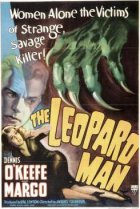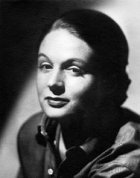
The Leopard Man Page #4
- APPROVED
- Year:
- 1943
- 66 min
- 467 Views
She puts the broom in the corner and goes to where Pedro is
seated. Here she stands a moment, fondly watching him as he
masticates his beans. Behind her the door stealthily opens.
Teresa tries to sneak back into the room. Mamacita sees the
movement and makes a tempestuous rush toward her, but Teresa
sidles out of the door before she can be caught. Mamacita,
muttering, slams the door shut and with difficulty pushes the
heavy, rust-covered iron bolt into place.
EXT. DOORWAY DELGADO HOUSE - NIGHT
Teresa stands outside the door. We hear the heavy bolt inside
driven home forcibly.
SRA. DELGADO'S VOICE
Now �� you will not come in again,
not until you bring the corn meal
with you!
EXT. STREET OUTSIDE DELGADO HOUSE - NIGHT
Teresa steps down from the single doorstep outside her house.
She crosses her arms and pulls her shoulders together in a
gesture of fear. She looks once, despairingly, at the closed
door behind her �� and then reluctantly steps out into the
dirt road and starts walking.
EXT. CALDERON GROCERY - NIGHT
Only a large corner window, with the word. "Provisiones"
printed on it shows that this ordinary house is a grocery
store. In the moonlight, one can see a few boxes of groceries
stacked on shelves inside. Teresa comes up to the window and
peers in. She knocks on the window.
TERESA:
Senora Calderon It is Teresa,
Senor. Teresa Delgado.
Over Teresa's shoulder, we see the interior of the little
store light up dimly as a curtain is pulled at the back of
the room. Beyond the curtain is revealed another room,
brightly lit by a bare electric globe hanging from the
ceiling on a cord. Under the light, a man sits at a table,
heartily eating from a plate heaped with food. The curtain
has been pulled back by Senora Calderon. We see her only in
silhouette and the details of her face and figure are
indistinguishable. We do see, however, that her long black
hair is down her back and she is braiding it. She walks a
little ways into the darkened store.
SRA. CALDERON
(speaking loudly to be
heard through the window)
The store is closed.
TERESA:
I just want a sack of corn meal for
my father's supper!
SRA. CALDERON
Tomorrow.
TERESA:
(imploringly)
It'll just take a second. ..Please
��or I must go clear across the
Arroyo to the big grocery --
Teresa taps against the window hopefully. But Sra. Calderon
turns back toward the doorway into the inner room, where the
solitary feaster hasn't even bothered to look up during this
exchange.
SRA. CALDERON
(as she goes)
It means taking off the lock again,
putting on the light, measuring the
meal. It's too much trouble. Once I
close, I close!
Sm. Calderon steps into the inner room and draws the curtain
closed behind her, as she speaks the last words. Again the
store is in darkness -- only a rim of light showing around
the edges of the curtained doorway.
TERESA:
(quietly � hopelessly)
Senora...
There is no reply. Teresa turns away.
DISSOLVE TO:
EXT. EDGE OF ARROYO - NIGHT
The Arroyo is a deep narrow cut in the mesa, bone�dry in this
season. Its floor of bleached sand and weeds stretches
desolately wider a vast moonlit sky. Here and there,
children's feet have scuffed steep little trails down the
banks.
Teresa appears at the top of one of these trails. She looks
down into the Arroyo -- and then off to the right.
A distance down the Arroyo is a bridge which carries a train
track across the dry river bed. To divert the rush of rain
water in winter and spring, the bridge is underpropped by two
slanting stone piers. They stand out like ribs against the
blackness of the underpass, which they divide into three
tunnels.
Teresa's face shows her dread of the Arroyo. She turns back
the way she came, takes a step away, hesitates and then
returns to the edge of the bank.
She starts down the little trail, her feet sliding in the
loose sand and a shower of pebbles bouncing down ahead of
her.
EXT.ARROYO FLOOR � NIGHT
Teresa stands at the bottom of the bank. She looks off to the
bridge again. Then she starts walking forward slowly, a very
little figure in the large loneliness of the night.
EXT. EAST SIDE OF BRIDGE - NIGHT
Teresa comes up to the face of the underpass with its three
openings. She stares from one black tunnel mouth to another.
She glances behind her, then looks at the underpass again.
Teresa goes forward again, toward the middle tunnel.
EXT. EAST ENTRANCE OF MIDDLE TUNNEL - NIGHT
The roof of the underpass is only a little higher than
Teresa's head and the passage is not more than ten feet wide.
The opening is dimly lit by the moonlight, but beyond it is
dense blackness. Teresa enters slowly. She takes a few steps
toward the blackness �- and stops. She listens. Teresa moves
forward again, walking as lightly as possible. The light dims
rapidly, so that after Teresa has taken a half dozen steps,
she is swallowed up in complete blackness.
The CAMERA HOLDS for a moment on the dark underpass before
Teresa emerges from the blackness on the West side. A light
scratching sound is heard. Teresa's eyes widen in panic as
she hears it and she hurries out of the tunnel, watching
fearfully ever her left shoulder. She must cut across in
front of this other tunnel in order to get to the south bank.
She starts across, never taking her eyes off the black tunnel
mouth. Suddenly she gives a convulsive start and a little cry
escapes before she can control it. A shadowy shape, low to
the ground, detaches itself from the dimness of the tunnel
opening and moves toward her. Almost at once, we see that it
is a large tumbleweed, blowing clown the Arroyo in the wind.
Teresa sighs soundlessly and goes on to the foot of the bank.
She starts scrambling up another steep little path.
DISSOLVE:
INT. BIG GROCERY STOPE - NIGHT
This is a fairly good�sized room, lined with shelves and
counters. A tall, Indian-type Mexican with iron-grey hair
puts a paper sack of cornmeal on the counter in front of
Teresa.
She starts toward the door, but noticing a bronze cage with
two toy birds in it, a mechanical device which has stood
there for years, she goes toward it, puts down her sack of
corn meal and goes up close.
TERESA:
Oh, the toy birds!
MANUEL:
You've seen them before. I couldn't
chase you away from the counter
when you were a little girl.
She winds up the bird cage.
TERESA:
I'd forgotten them.
MANUEL:
(smiling, goodhumoredly,
skeptical)
Every day you see them --and you
have forgotten them? Oh, I remember
my little Teresita -- I remember
the little girl who was afraid of
the dark. They shouldn't send you.
The birds have begun to sing,a highly mechanical rendering of
a bird song.
TERESA:
I'm not afraid. What could happen
to me?
The birds sing and she pretends to listen. Manuel leans
against the inner door of the grocery watching her, smiling
and amused. Finally his smiling irks her into action. She
picks up her sack of corn meal.
Translation
Translate and read this script in other languages:
Select another language:
- - Select -
- 简体中文 (Chinese - Simplified)
- 繁體中文 (Chinese - Traditional)
- Español (Spanish)
- Esperanto (Esperanto)
- 日本語 (Japanese)
- Português (Portuguese)
- Deutsch (German)
- العربية (Arabic)
- Français (French)
- Русский (Russian)
- ಕನ್ನಡ (Kannada)
- 한국어 (Korean)
- עברית (Hebrew)
- Gaeilge (Irish)
- Українська (Ukrainian)
- اردو (Urdu)
- Magyar (Hungarian)
- मानक हिन्दी (Hindi)
- Indonesia (Indonesian)
- Italiano (Italian)
- தமிழ் (Tamil)
- Türkçe (Turkish)
- తెలుగు (Telugu)
- ภาษาไทย (Thai)
- Tiếng Việt (Vietnamese)
- Čeština (Czech)
- Polski (Polish)
- Bahasa Indonesia (Indonesian)
- Românește (Romanian)
- Nederlands (Dutch)
- Ελληνικά (Greek)
- Latinum (Latin)
- Svenska (Swedish)
- Dansk (Danish)
- Suomi (Finnish)
- فارسی (Persian)
- ייִדיש (Yiddish)
- հայերեն (Armenian)
- Norsk (Norwegian)
- English (English)
Citation
Use the citation below to add this screenplay to your bibliography:
Style:MLAChicagoAPA
"The Leopard Man" Scripts.com. STANDS4 LLC, 2025. Web. 3 Mar. 2025. <https://www.scripts.com/script/the_leopard_man_896>.







Discuss this script with the community:
Report Comment
We're doing our best to make sure our content is useful, accurate and safe.
If by any chance you spot an inappropriate comment while navigating through our website please use this form to let us know, and we'll take care of it shortly.
Attachment
You need to be logged in to favorite.
Log In